Early Verdict
The Sulon Cortex is a great concept but it's still very much a prototype. We probably won't see a finished device for another year or more.
Pros
- +
Both AR and VR device
- +
Untethered is possibility
Cons
- -
Latency could be better
- -
Bulky
- -
Battery life unknown
- -
Specs unknown
Why you can trust TechRadar
Merging augmented and virtual reality together sounds like a dream come true, which is probably why company Sulon Technologies is so excited to show off its device.
Pre-orders for the Sulon Cortex developer's kit launched around March 2014 but shipping will take place later this year for a hefty $499 (£337, AU$653).
The Sulon Cortex essentially turns your surrounding environment into an augmented or virtual reality experience thanks to the sensors on the headset that are "spatially-aware" of your surroundings.
Unlike the Oculus Rift which requires a PC, Sony's Project Morpheus which needs a PS4 and the Samsung Gear VR which requires a Galaxy Note 4 phone, the final build of the Cortex promises an untethered experience so you can walk around the scene you're in.
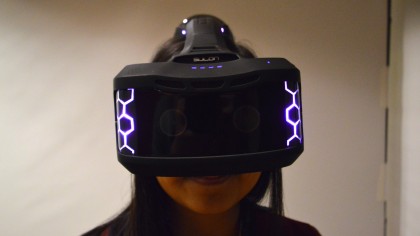
The HMD can work both indoors and outdoors and supposedly doesn't need extra cameras or sensors nor is it affected by ambient light because it can spatially map environments in real time.
There are also two different types of HMD's - the tethered and untethered. The wired headset has a large, eight-balls-esque sensor on the back, which also makes you look even weirder than usual for VR/AR devices.
The Cortex in general is actually a sleek and attractive device. You can customize the colors of the hexagonal lights on the sides to blue, green, pink and purple. There may even be more options later.
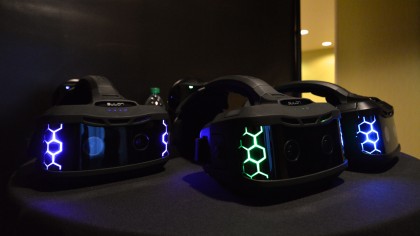
There's plenty of padding on the inside and it fits on your face like an Oculus. I found the extra cushion to be more comfortable than the Rift but so far nothing has beat the comfort of the Morpheus for me.
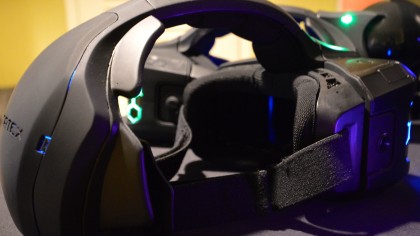
I was also able to wear my glasses with the Cortex which was a nice perk. It wasn't ideal but without diopters to adjust the lenses, it worked well enough.
Like the Morpheus, you get sound from the Cortex from plugging headphones directly into the HMD.
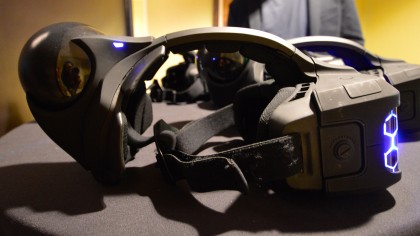
My demo during GDC 2015 wasn't as involved as the ones shown during CES earlier this year. Rather than interacting with the environment, I was more or less, inspecting it.
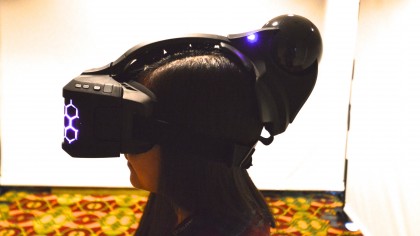
Specifically, I was literally in the middle of a fight scene between two soldiers in a subway station. Developed on Unreal Engine by Epic Games and presented in 2D, the scene allowed a 360 experience where a punch could be paused so I could walk around it, observing from different angles.
I was told I could also lay down or continually pause the fight to observe from whatever angle I wished, which was pretty awesome. It was like the scene from The Matrix where the scene stops and the camera pans all around so you can see every single bullet. It also reminded me of a demo on the Oculus which had the same effect. My experience was also a tethered one and on a device that wasn't a completely finished prototype.
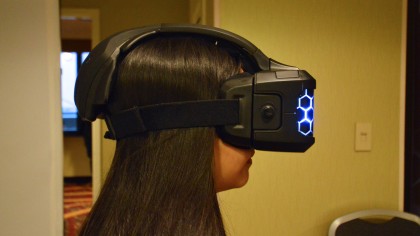
The Cortex also mapped out the scene to match the room I was in. Running into a gross subway wall equaled running into the wall of the room I was in.
While the mapping was neat and spot on, the scene itself was jittery at times. I did the demo twice with it being re-calibrated the second time. It was better but I think lowering the latency will be key before the Cortex releases.
The headset was also a little cumbersome but didn't feel nearly as heavy as an Oculus. If anything, it was in between the Rift and the Morpheus with the latter feeling the lightest.
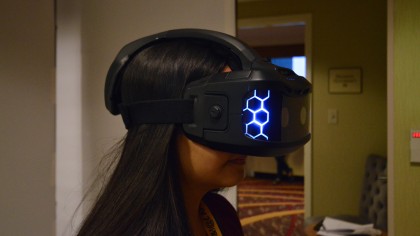
Official specs haven't been released yet but I was told a couple hours would be the maximum length of time the untethered prototype could run - which makes sense and likely aligns with what the HoloLens battery life could be like.
Early Verdict
The Sulon Cortex AVR headset is a device heading in an interesting direction. In a splintered industry where there are two different types of technology, combining the two may be the way to go and it looks like Sulon has a headstart. Oculus Rift inventor Palmer Luckey even said that the best VR headsets would be a hybrid of both AR and VR.
The Cortex is already a promising device and has served up several great experiences, most of which place it a tier under the "mainstream" VR headsets out there.
Now all the company needs to do is continue fixing the latency issues, and likely battery life. Then AR and VR can live together harmoniously within a Sulon Cortex, possibly in your living room.
What is a hands on review?
Hands on reviews' are a journalist's first impressions of a piece of kit based on spending some time with it. It may be just a few moments, or a few hours. The important thing is we have been able to play with it ourselves and can give you some sense of what it's like to use, even if it's only an embryonic view. For more information, see TechRadar's Reviews Guarantee.
